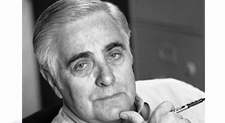By Jesse Lopez/reporter

A former Dallas Morning News investigative reporter shared his experiences during the Kennedy assassination Nov. 4 on NE Campus.
Hugh Aynesworth, author of November 22, 1963: Witness to History, spoke to the 400 in attendance about the day President John F. Kennedy was shot.
“The day started off as a very unusual day,” he said.
Working at the paper, he was in the office answering phones while the other reporters were covering other stories, and he was “ticked off” about it. Having been there three years, he thought he should be working too, not stuck behind a desk.
“Finally, I got tired of answering the phones,” he said. “So I decided to walk over to the main street where the motorcade was coming down.”
Everyone he passed was exuberant, and it was a beautiful November day, Aynesworth said. He ended up next to the Texas School Book Depository and was there to see the Kennedys as their motorcade started to pass. That was when he heard the first gunshot.
“All of sudden, I heard what sounded like a motorcycle backfire,” he said. “A few seconds later, I heard another shot, then another.”
After that chaos broke out, people were running in every direction, unsure of where the shots were coming from. At that moment, Aynesworth said his “newspaper background” kicked in, and he knew he needed to start interviewing people. Howard Brennan, the first man he interviewed, was the person who gave police a description of Lee Harvey Oswald.
“He described him so perfectly,” Aynesworth said.
So “perfectly” that description was used for the all-points bulletin that would later lead to Oswald’s capture.
While interviewing people after the shooting, he heard on a motorcycle radio that a police officer had been shot in Oak Cliff. Making what he called the “smartest decision he made that day,” he grabbed two News 8 people and headed to Oak Cliff. There he interviewed six or seven more eyewitnesses who saw the shooting and saw Oswald flee the scene. Again, he heard a police radio broadcast Oswald’s location. Even though he was scared, he said he ran the seven blocks to the Texas Theater.
“There, I asked the stupidest question of the day,” he said. “I asked the lady in front of the ticket window if he bought a ticket.”
Inside, he saw 13 or 14 other people and two officers looking for Oswald. There he saw the capture of the suspected shooter. The following day, he heard the police were moving Oswald. Again by what he called “luck,” he saw Jack Ruby shoot and kill Oswald.
Aynesworth said he had seen Ruby the morning of the assassination having breakfast.
“I knew Jack, but I never liked him and didn’t respect him,” he said.
Aynesworth was one of the few reporters to speak to Ruby in jail. He also spoke to the Oswald family.
During a question-and-answer session, Aynesworth gave his opinion on why Oswald shot Kennedy but did not confess.
“I think he wanted to be somebody,” he said. “I think that if he had confessed that, they would have had no need for a trial. And that’s what I think he wanted, and so did his brother.”
Aynesworth also said he doesn’t believe the conspiracy theories. He believes they started because people didn’t have all the facts and didn’t question the people who should have been interviewed. Although he did the news report and spoke to several eyewitnesses, Aynesworth was never interviewed. He believes conspiracy theories exist for one underlying reason.
“We don’t want to believe,” he said. “It’s very unsettling to believe that two nobodies could change the course of history, but they did.”

